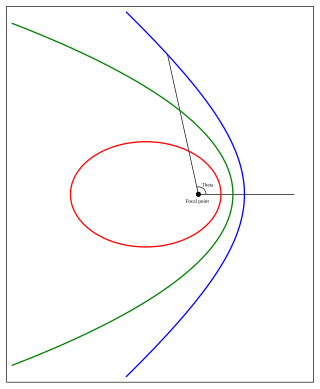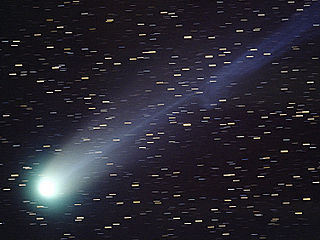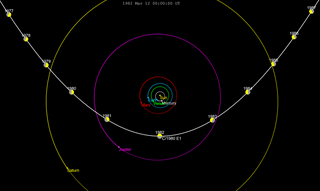Related Research Articles

A comet is an icy, small Solar System body that warms and begins to release gases when passing close to the Sun, a process called outgassing. This produces an extended, gravitationally unbound atmosphere or coma surrounding the nucleus, and sometimes a tail of gas and dust gas blown out from the coma. These phenomena are due to the effects of solar radiation and the outstreaming solar wind plasma acting upon the nucleus of the comet. Comet nuclei range from a few hundred meters to tens of kilometers across and are composed of loose collections of ice, dust, and small rocky particles. The coma may be up to 15 times Earth's diameter, while the tail may stretch beyond one astronomical unit. If sufficiently close and bright, a comet may be seen from Earth without the aid of a telescope and can subtend an arc of up to 30° across the sky. Comets have been observed and recorded since ancient times by many cultures and religions.
Damocloids are a class of minor planets such as 5335 Damocles and 1996 PW that have Halley-type or long-period highly eccentric orbits typical of periodic comets such as Halley's Comet, but without showing a cometary coma or tail. David Jewitt defines a damocloid as an object with a Jupiter Tisserand invariant (TJ) of 2 or less, while Akimasa Nakamura defines this group with the following orbital elements:

In astrodynamics, the orbital eccentricity of an astronomical object is a dimensionless parameter that determines the amount by which its orbit around another body deviates from a perfect circle. A value of 0 is a circular orbit, values between 0 and 1 form an elliptic orbit, 1 is a parabolic escape orbit, and greater than 1 is a hyperbola. The term derives its name from the parameters of conic sections, as every Kepler orbit is a conic section. It is normally used for the isolated two-body problem, but extensions exist for objects following a rosette orbit through the Galaxy.

7604 Kridsadaporn, provisional designation 1995 QY2, is an unusual, carbonaceous asteroid and Mars-crosser on a highly eccentric orbit from the outer regions of the asteroid belt, approximately 12 kilometers (7.5 miles) in diameter. It was discovered on 31 August 1995, by Australian astronomer Robert McNaught at Siding Spring Observatory near Coonabarabran, Australia. Due to its particular orbit, the C-type asteroid belongs to MPC's list of "other" unusual objects, and has been classified as an "asteroid in cometary orbit", or ACO. The asteroid was named in memory of Thai astronomer Kridsadaporn Ritsmitchai.

An interstellar object is an astronomical object in interstellar space that is not gravitationally bound to a star. This term can also be applied to an object that is on an interstellar trajectory but is temporarily passing close to a star, such as certain asteroids and comets. In the latter case, the object may be called an interstellar interloper.

C/1980 E1 is a non-periodic comet discovered by Edward L. G. Bowell on 11 February 1980 and which came closest to the Sun (perihelion) in March 1982. It is leaving the Solar System on a hyperbolic trajectory due to a close approach to Jupiter. In the 42 years since its discovery only two objects with higher eccentricities have been identified, 1I/ʻOumuamua (1.2) and 2I/Borisov (3.35).

Comets have been observed for over 2,000 years. During that time, several different systems have been used to assign names to each comet, and as a result many comets have more than one name.
In observational astronomy, the observation arc of a Solar System body is the time period between its earliest and latest observations, used for tracing the body's path. It is usually given in days or years. The term is mostly used in the discovery and tracking of asteroids and comets. Arc length has the greatest influence on the accuracy of an orbit. The number, spacing of intermediate observations, and timestamps have a lesser effect.
2005 VX3 is trans-Neptunian object and retrograde damocloid on a highly eccentric, cometary-like orbit. It was first observed on 1 November 2005, by astronomers with the Mount Lemmon Survey at the Mount Lemmon Observatory in Arizona, United States. The unusual object measures approximately 7 kilometers (4 miles) in diameter. It has the 3rd largest known heliocentric semi-major axis and aphelion. Additionally its perihelion lies within the orbit of Jupiter, which means it also has the largest orbital eccentricity of any known minor planet.
2002 RN109 is a trans-Neptunian object and damocloid on a highly eccentric, cometary-like orbit. It was first observed on 6 September 2002, by astronomers with the Lincoln Near-Earth Asteroid Research at the Lincoln Lab's ETS near Socorro, New Mexico, in the United States. The unusual object measures approximately 4 kilometers (2 miles) in diameter. It has the second highest orbital eccentricity of any known minor planet, after 2005 VX3.

514107 Kaʻepaokaʻāwela, provisionally designated 2015 BZ509 and nicknamed Bee-Zed, is a small asteroid, approximately 3 km (2 mi) in diameter, in a resonant, co-orbital motion with Jupiter. It is an unusual minor planet in that its orbit is retrograde, which is opposite to the direction of most other bodies in the Solar System. It was discovered on 26 November 2014, by astronomers of the Pan-STARRS survey at Haleakala Observatory on the island of Maui, United States. Kaʻepaokaʻāwela is the first example of an asteroid in a 1:–1 resonance with any of the planets. One study suggests that it was an interstellar asteroid captured 4.5 billion years ago into an orbit around the Sun.

ʻOumuamua is the first interstellar object detected passing through the Solar System. Formally designated 1I/2017 U1, it was discovered by Robert Weryk using the Pan-STARRS telescope at Haleakalā Observatory, Hawaii, on 19 October 2017, approximately 40 days after it passed its closest point to the Sun on 9 September. When it was first observed, it was about 33 million km from Earth and already heading away from the Sun.

C/2017 U7 (PanSTARRS) is a hyperbolic comet, first observed on 29 October 2017 by astronomers of the Pan-STARRS facility at Haleakala Observatory, Hawaii, United States when the object was 7.8 AU (1.2 billion km) from the Sun. Despite being discovered only 10 days after interstellar asteroid 1I/'Oumuamua, it was not announced until March 2018 as its orbit is not strongly hyperbolic beyond most Oort Cloud comets. Based on the absolute magnitude of 10.6, it may measure tens of kilometers in diameter. As of August 2018, there is only 1 hyperbolic asteroid known, ʻOumuamua, but hundreds of hyperbolic comets are known.

C/2018 C2 (Lemmon) is a hyperbolic comet. It was first observed on 5 February 2018 by the Mount Lemmon Survey conducted at the Mount Lemmon Observatory near Tucson, Arizona, in the United States. The discovery was announced on 4 March 2018 along with another hyperbolic object, A/2017 U7. Based on the absolute magnitude of 15.1, it may measure several kilometers in diameter. On 22 March 2018 it was determined to be a hyperbolic comet.

C/2018 F4 (PanSTARRS) is a hyperbolic comet. It was discovered on 17 March 2018 when it was beyond the orbit of Jupiter, 6.4 AU (960 million km) from the Sun. It was quite far from the Sun and turned out to simply be an asteroidal object that was discovered before cometary activity was noticeable. As perihelion is inside the orbit of Jupiter, this object should become more active. In April 2018 it was determined to be a hyperbolic comet. Given that the incoming velocity was similar to that of an Oort cloud object, we can very confidently say that it is not of interstellar origin. C/2018 F4 fragmented around August 2020.
In planetary science, the term unusual minor planet, or unusual object, is used for a minor planet that possesses an unusual physical or orbital characteristic. For the Minor Planet Center (MPC), which operates under the auspices of the International Astronomical Union, any non-classical main-belt asteroid, which account for the vast majority of all minor planets, is an unusual minor planet. These include the near-Earth objects and Trojans as well as the distant minor planets such as centaurs and trans-Neptunian objects. In a narrower sense, the term is used for a group of bodies – including main-belt asteroids, Mars-crossers, centaurs and otherwise non-classifiable minor planets – that show a high orbital eccentricity, typically above 0.5 and/or a perihelion of less than 6 AU. Similarly, an unusual asteroid (UA) is an inner Solar System object with a high eccentricity and/or inclination but with a perihelion larger than 1.3 AU, which does exclude the near-Earth objects.

2I/Borisov, originally designated C/2019 Q4 (Borisov), is the first observed rogue comet and the second observed interstellar interloper after ʻOumuamua. It was discovered by the Crimean amateur astronomer and telescope maker Gennadiy Borisov on 29 August 2019 UTC.
(523676) 2013 UL10 (prov. designation:2013 UL10) is a reddish centaur with cometary activity orbiting the Sun between Jupiter and Uranus. It was discovered on 18 August 2010, by a team of astronomers with the Pan-STARRS survey at the Haleakalā Observatory, Hawaii. It is the first centaur known to have both comet-like activity and red surface colors. It is also one of the smallest centaurs, with a nucleus of no more than 10 kilometers (6.2 miles) in diameter. As of 2021, it has not been named.
References
- ↑ "JPL Solar System Dynamics".
- ↑ "Hyperbolic Asteroids | Space Reference". www.spacereference.org. Retrieved 12 November 2019.
- ↑ "JPL Small-Body Database Search Engine: orbital class Hyperbolic Asteroid (HYA)". Jet Propulsion Laboratory Solar System Dynamics. Retrieved 4 March 2018.
- ↑ Web Archive from 5 March 2018 for A/2017 U7
- ↑ Web Archive from 5 March 2018 for A/2018 C2
- ↑ Web Archive from 28 March 2018 for A/2018 F4
- ↑ "A/2019 O3". JPL Small-Body Database Browser. Retrieved 28 December 2019.
- ↑ "C/2019 G4". JPL Small-Body Database Browser. Retrieved 11 August 2022.
- ↑ Croswell, Ken (2017). "Astronomers race to learn from first interstellar asteroid ever seen". Nature News. doi:10.1038/nature.2017.22925.
- ↑ de la Fuente Marcos, Carlos; de la Fuente Marcos, Raúl; Aarseth, Sverre J. (6 February 2018). "Where the Solar system meets the solar neighbourhood: patterns in the distribution of radiants of observed hyperbolic minor bodies". Monthly Notices of the Royal Astronomical Society Letters. 476 (1): L1–L5. arXiv: 1802.00778 . Bibcode:2018MNRAS.476L...1D. doi:10.1093/mnrasl/sly019.